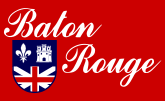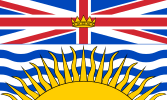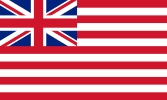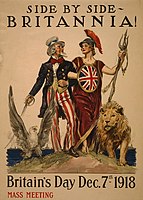Union Jack
 | |
| Use | National flag |
|---|---|
| Proportion | commonly 1:2 or 3:5 and other[1] |
| Adopted |
|
| Design | Blue field on which theCross of Saint Andrewcounterchangedwith theCross of Saint Patrick,over all theCross of Saint Georgefimbriated. |
TheUnion Jack[2][3]orUnion Flagis thede factonationalflag of the United Kingdom.The Union Flag was also used as the official flag of severalBritish coloniesanddominionsbefore they adopted their own national flags. The flag continues to have official status in Canada, by parliamentary resolution, where it is known as theRoyal Union Flag.[4]
It is sometimes asserted that the termUnion Jackproperly refers only to naval usage, but this assertion was dismissed by theFlag Institutein 2013 after historical investigations.[5][6][7][note 1]The origins of the earlierflag of Great Britaindate from 1606.King James VI of Scotlandhad inherited the English and Irish thrones in 1603 as James I, therebyuniting the crownsofEngland,Scotland,andIrelandin apersonal union,although the three kingdoms remained separate states. On 12 April 1606, a new flag to represent this regal union between England and Scotland was specified in a royal decree, according to which theflag of England,a red cross on a white background, known asSt George's Cross,and theflag of Scotland,a whitesaltire(X-shaped cross, or St Andrew's Cross) on a blue background, would be joined, forming the flag of England and Scotland for maritime purposes.
The present design of the Union Flag dates from a royal proclamation following theunionofGreat BritainandIrelandin 1801.[9]The flag combines aspects of three older national flags: the red cross ofSt Georgefor the Kingdom of England, the white saltire ofSt Andrewforthe Kingdom of Scotlandand thered saltireofSt Patrickto representIreland.Although theRepublic of Irelandis no longer part of the United Kingdom,Northern Irelandis. There are nosymbols representing Walesin the flag, makingWalesthe onlyhome nationwith no direct representation, as at the time of theLaws in Wales Acts 1535 and 1542(creating legal union with England) the concept ofnational flagswas in its infancy. TheWelsh Dragonwas, however, adopted as asupporterin theroyal coat of arms of Englandused by theTudor dynastyfrom 1485.[10]
The flags ofBritish Overseas Territories,as well as certain sovereign states and regions that were previouslyBritish possessions,incorporate the Union Flag into their own flag designs or have official flags that are derived from the Union Jack. Many of these flags are blue or red ensigns with the Union Flag in thecantonanddefacedwith the distinguishing arms of the territory. The governors of British Overseas Territories and the Australian states, as well as the lieutenant governor of Nova Scotia also have personal standards that incorporate the Union Flag in their design.
Terminology
[edit]The termsUnion JackandUnion Flagare both used historically for describing the national flag of the United Kingdom. Whether the termUnion Jackapplies only when used as ajackflag on a ship is a matter of debate.[11]
According to the website of theParliament of the United Kingdom:[12][13]"Until the early 17th century England and Scotland were two entirely independent kingdoms (Wales had been annexed into theKingdom of Englandunder theLaws in Wales Acts 1535 and 1542.). This changed dramatically in 1603 on the death ofElizabeth I of England.Because the Queen died unmarried and childless, the English crown passed to the next available heir, her cousinJames VI, King of Scotland.England and Scotland now shared the same monarch under what was known as a union of the crowns. "[7]Each kingdom had its own national flag for ships, but in 1606 James VI and I introduced a combined national flag.[14]The UK Parliament website states "The result was the Union Jack, Jack being a shortening of Jacobus, the Latin version of James".[13]
The etymology ofjackin the context of flagstaffs reaches back to Middle German. The suffix-kinwas used in Middle Dutch and Middle German as adiminutive.[15]Examples occur in bothChaucerandLanglandthough the form is unknown in Old English.[15]Johnis a common male forename (going back to the Bible), appearing in Dutch asJan.Both languages use it as a generic form for a man in general.[16]The two were combined in the Middle DutchJanke,whence Middle FrenchJakkeand Middle EnglishJack.[17]Jackcame to be used to identify all manner of particularly small objects or small versions of larger ones. TheOEDhas definition 21 "Something insignificant, or smaller than the normal size" and gives examples from 1530 to 2014 of this usage.[17]Further examples in the compounds section at 2b illustrate this.[17]The original maritime flag use ofjackwas "A ship's flag of a smaller size than the ensign, used at sea as a signal, or as an identifying device".[18]The jack was flown in the bows or from the head of the spritsail mast to indicate the vessel's nationality: "You are alsoe for this present service to keepe in yorJack at yorBoultspritt end and yorPendant and yorOrdinance "[19]The Union Flag when instantiated as a small jack became known as the "Union Jack" and this later term transferred to more general usage of the Union Flag.[20]

Also later a short flagpole was placed in the bows of a ship to fly the jack, this became known as thejackstaff.[21]
According to theFlag Institute,a membership-runvexillologicalcharity,[22]"the national flag of the United Kingdom, the Crown Dependencies and Overseas Territories is the Union Flag, which may also be called the Union Jack."[23]The institute has also stated:
it is often stated that the Union Flag should only be described as the Union Jack when flown in the bows of a warship, but this is a relatively recent idea. From early in its life the Admiralty itself frequently referred to the flag as the Union Jack, whatever its use, and in 1902 an Admiralty circular announced that Their Lordships had decided that either name could be used officially. In 1908, a government minister stated, in response to a parliamentary question, that "the Union Jack should be regarded as the National flag".[11][24]
Notwithstanding Their Lordships' circular of 1902, by 1913 the Admiralty described the "Union Flag" and added in a footnote that 'A Jack is a Flag to be flown only on the "Jack" Staff'.[25]
However, the authoritativeA Complete Guide to Heraldrypublished in 1909 byArthur Charles Fox-Daviesuses the term "Union Jack".[26]
The term "Union Flag" is used inKing Charles I's1634 proclamation:
... none of Our Subjects, of any of Our Nations and Kingdoms shall from henceforth presume to carry the Union Flag in the Main top, or other part of any of their Ships (that is) St Georges cross and St Andrew's Cross joined together upon pain of Our high displeasure, but that the same Union Flag be still reserved as an ornament proper for Our own Ships and Ships in our immediate Service and Pay, and none other. "[27]
— Proclamation appointing the Flag, as well for Our Navy Royal as for the Ships of Our Subjects of South and North Britain – 5 May 1634
and inKing George III's proclamation of 1 January 1801 concerning the arms and flag of the United Kingdom of Great Britain and Ireland:
And that the Union Flag shall be Azure, the Crosses Saltires of St. Andrew and St. Patrick Quarterly per Saltire, counterchanged Argent and Gules; the latter fimbriated of the Second, surmounted by the Cross of St. George of the Third, fimbriated as the Saltire:...[28]
— A Proclamation Declaring His Majesty's Pleasure concerning the Royal Style and Titles appertaining to the Imperial Crown of the United Kingdom of Great Britain and Ireland, and its Dependencies, and also the Ensigns, Armorial Flags, and Banners thereof "
When the first flag representing Britain was introduced on theproclamationofKing James Iin 1606,[29]it became known simply as the "British flag" or the "flag of Britain". The royal proclamation gave no distinctive name to the new flag. At thefuneral of King Jamesin 1625 the flag was called the "Banner of the Union of the two Crosses of England and Scotland".[30]The wordjackwas in use before 1600 to describe themaritime bow flag.[11]By 1627 a small Union Jack was commonly flown in this position. One theory goes that for some years it would have been called just the "Jack", or "Jack flag", or the "King's Jack", but by 1674, while formally referred to as "His Majesty's Jack", it was commonly called the "Union Jack", and this was officially acknowledged.[9][7]

A proclamation issued by King George III at the time of theUnion of 1801concerned flags at sea and repeatedly referred to "Ensigns, Flags, Jacks, and Pendants" and forbade merchant vessels from wearing "Our Jack, commonly called the Union Jack" nor any pendants or colours used by the King's ships.[31]Reinforcing the distinction the King's proclamation of the same day concerning the arms and flag of the United Kingdom (not colours at sea) called the new flag "the Union Flag".[32]
The size and power of theRoyal Navyinternationally at the time could also explain why the flag was named the "Union Jack"; considering the navy was so widely utilised and renowned by the United Kingdom andcolonies,it is possible that the termjackoccurred because of its regular use on all British ships using the jackstaff (a flag pole attached to the bow of a ship). The name may alternatively come from the 'jack-et' of the English or Scottish soldiers, or from the name of James I who originated the first union in 1603. Even if the termUnion Jackdoes derive from the jack flag, after three centuries, it is now sanctioned by use and has appeared in official use, confirmed as the national flag by Parliament and remains the popular term.[33]
Winston Churchill,British Prime Ministerfrom 1940 to 1945, referred to the flag of the United Kingdom as the Union Jack. In March 1899, Churchill wrote tohis motherfromIndiaabout her plans to produce a new trans-Atlantic magazine, to be calledThe Anglo-Saxon Review.The drawing at the end of this letter was deliberately facetious, teasing her for going down-market, and in the accompanying letter he wrote, "Your title 'The Anglo Saxon' with its motto 'Blood is thicker than water' only needs the Union Jack & theStar Spangled Bannercrossed on the cover to be suited to one ofHarmsworth's cheap Imperialist productions. "[34]

More recently, Reed'sNautical Almanac(1990 edition) unambiguously stated: "The Union Flag, frequently but incorrectly referred to as the Union Jack,..." and later: "8. The Jack – A small flag worn on a jackstaff on the stem of Naval Vessels. The Royal Navy wears the Union Flag... This is the only occasion when it correct to describe the flag as the Union Jack".[35]However, this assertion does not appear in any Reed'sNautical Almanacsince 1993. In the 2016 Reed'sNautical Almanac,the only entry where this might appear, section 5.21, covering Flag Etiquette, does not include this statement. Within theAlmanac,neither the Union Flag nor the Union Jack are included pictorially or mentioned by name.
For comparison with another anglophone country with a large navy,jack of the United Statesspecifically refers to the flag flown from the jackstaff of a warship, auxiliary or other U.S. governmental entity.[36]
TheButcher's Apronis apejorativeterm for the flag, common amongIrish republicans,citing the blood-streaked appearance of the flag and referring to atrocities committed in Ireland and other countries under British colonial rule.[37][38]In 2006,Sandra White,aMember of the Scottish Parliament,caused a furore when the term was used in a press release under her name. It was later blamed on the actions of a researcher, who resigned yet claimed that the comment had been approved by White.[39]The Irish folk bandthe Wolfe Toneshas a song entitled "The Butcher's Apron" which makes reference to the term.[40]
In theChinese language,the flag has the nicknameRice-Character Flag(Mễ tự kỳ;MandarinPinyin:mǐzìqí,CantoneseJyutping:mai5zi6kei4), since the pattern looks like the Chinese character for "rice" (Mễ).[41]
Design
[edit]
The current flag's design has been in use since 1801. Its originalblazon,as decreed byGeorge III of the United Kingdomon 1 January 1801, reads:
the Union flag shall be azure, the crosses-saltires of St. Andrew and St. Patrick quartered per saltire counter changed argent and gules; the latter fimbriated of the second [viz., argent]; surmounted by the cross of St. George of the third [viz., gules], fimbriated as the saltire [viz., argent].[42]
Specification
[edit]The Union Jack is normally twice as long as it is tall, a ratio of 1:2. In the United Kingdom, land flags are normally a ratio of 3:5; the Union Jack can also be made in this shape, but is 1:2 for most purposes. In 2008, MPAndrew Rosindellproposed aTen Minute Rulebill to standardise the design of the flag at 3:5, but the bill did not proceed past the first reading.[43]
The three-component crosses that make up the Union Flag are sized as follows:[44]
- The redSt George's Crosswidth is1⁄5of the flag's height with a1⁄15flag heightfimbriation
- The white diagonalSt Andrew's Crosswidth is1⁄5of the flag's height, visible on either side of the St Patrick's Cross in diagonals of1⁄10and1⁄30of the flag's height, respectively.
- The red diagonalSt Patrick's Crosswidth is1⁄15of the flag's height. It is offset by1⁄30of the flag's height in an anti-clockwise direction[clarification needed].According to the official blazon of 1801, the white diagonalSt Andrew's Crossis in factcounterchangedwith the red diagonal ofSt Patrick's Cross.In this interpretation, the width of both saltires is1⁄15of the flag's height, with fimbriations of1⁄30of the flag's height on either side of the red saltire.
The crosses and fimbriations retain their thickness relative to the flag'sheightwhether they are shown with a ratio of 3:5 or 1:2.Heighthere is the distance from top to bottom which in vexillology is termedwidth or breadth.
Ratios
[edit]The Admiralty in 1864 settled all official flags at proportions of 1:2, but the relative widths of the crosses remained unspecified, with the above conventions becoming standardised in the 20th century.[45]In the 19th century, the Union flag was defined by the same blazon but could vary in its geometrical proportions.[46]
Although the most common ratio is 1:2, other ratios exist. The Royal Navy's flag code book, BR20Flags of All Nations,states that both 1:2 and 3:5 versions are official.[47]In the 3:5 version, the innermost points of the lower left and upper right diagonals of the St Patrick's cross are cut off or truncated. TheGarter King of Armsalso suggests a ratio of 3:5 as the suitable proportion for a Union Flag flown on land.[48]
The King's Harbour Master's flag, like the Pilot Jack, is a 1:2 flag that contains a white-bordered Union Flag that is longer than 1:2. The jacks of ships flying variants of theBlue Ensignare square and have a square Union Flag in the canton.[47]TheKing's Colours of Army regimentsare 36 by 43 inches (910 mm × 1,090 mm); on them, the bars of the cross and saltire are of equal width; so are their respective fimbriations, which are very narrow.[49]
In South Africa, the Union Jacks flown alongside the National Flag between 1928 and 1957 were 2:3 flags.[citation needed]
Colours
[edit]Although the official design of the flag at the College of Arms does not specify colours beyondazure,argentandgules(blue, white and red, respectively), according toGraham Bartram(chief vexillologist ofFlag Institute) the colours blue, red, and white are:[33][48][50]
| Scheme | Blue | Red | White |
|---|---|---|---|
| Refs. | [51] | [52] | |
| Pantone(paper) | 280 C | 186 C | Safe |
| HEX | #012169 | #C8102E | #FFFFFF |
| MoD | 8711D | 8711 | 8711J |
| NSN | 8305.99.130.4580 | 8305.99.130.4584 | 8305.99.130.4585 |
| CMYK | 100.85.5.22 | 2.100.85.6 | 0.0.0.0 |
| RGB | 1, 33, 105 | 200, 16, 46 | 255, 255, 255 |
AllHEX,CMYKandRGBspecifications for thePantonecolours are taken from the official Pantone website on the webpages of the corresponding colours. Although these colour specifications are official, not all of the colours are completely congruent. This is due to different specifications for different types of media (for example, screen and print).
Flying
[edit]The flag does not have reflection symmetry due to the slight pinwheeling of the St Patrick's and St Andrew's crosses, technically thecounterchangeof saltires.Thus, there is a correct side up. It is one of two national flags withtwo-fold rotational symmetry,symmetry groupC2,the other being theflag of Trinidad and Tobago.The original specification of the Union Flag in the royal proclamation of 1 January 1801 did not contain a drawn pattern or express which way the saltires should lie; they were simply "counterchanged" and the red saltire fimbriated. Nevertheless, a convention was soon established which accords most closely with the description. The flag was deliberately designed with the Irish saltire slightly depressed at the hoist end to reflect the earlier union with Scotland, giving as it were seniority to the Saint Andrew's cross.
When statically displayed, the hoist is on the observer's left. To fly the flag correctly, the white of St Andrew isabovethe red of St Patrick in the upper hoist canton (the quarter at the top nearest to the flag-pole). This is expressed by the phraseswide white topandbroadside up.An upside-down flag must beturned overto be flown correctly;rotating it180 degrees will still result in an upside-down flag.
The first drawn pattern for the flag was in a parallel proclamation on 1 January 1801, concerning civil naval ensigns, which drawing shows thered ensign(also to be used as a red jack byprivateers). As it appears in theLondon Gazette,the broad stripe is where expected for three of the four quarters, but the upper left quarter shows the broad stripe below.[31]
It is often stated that a flag upside down is a form of distress signal or even a deliberate insult. In the case of the Union Flag, the difference is subtle and is easily missed by the uninformed. It is often displayed upside down inadvertently—even on commercially-made hand waving flags.[53]
On 3 February 2009, the BBC reported that the flag had been inadvertently flown upside-down by the UK government at the signing of a trade agreement with Chinese premierWen Jiabao.The error had been spotted by readers of the BBC News website who had contacted the BBC after seeing a photograph of the event.[54]
History
[edit]In 1603,James VI of Scotlandinherited theKingdom of England(and the newly createdclient state,theKingdom of Ireland) as James I, therebyuniting the crownsin apersonal union.With Wales annexed into theKingdom of Englandunder theLaws in Wales Acts 1535 and 1542,James now ruled over all of the island ofGreat Britain,which he frequently described as a unified kingdom (though the parliaments of the Kingdom of England and theKingdom of Scotlanddid not actually unify until theKingdom of Great Britainwas formed in 1707).[33]In the wake of the 1603 personal union, several designs for a new flag were drawn up, juxtaposing theSaint George's Crossand theSt Andrew's Saltire,but none were acceptable to James:[55]

Various other designs for a common flag were drawn up following the union of the two Crowns in 1603, but were rarely, if ever, used.[56]One version showed St George's cross with St Andrew's cross in the canton, and another version placed the two crosses side by side. A painted wooden ceiling boss fromLinlithgow Palace,dated to about 1617, depicts the Scottish royal unicorn holding a flag where a blueSaltiresurmounts the red cross of St. George.
1606–1801
[edit]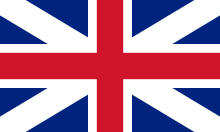
On 12 April 1606, a new flag to represent the regal union between England and Scotland was specified in a royal decree, according to which the flag of England (a red cross on a white background, known as St George's Cross), and the flag of Scotland (a white saltire on a blue background, known as the saltire or St Andrew's Cross), would be joined together,[9]forming the flag of Great Britain and first union flag:
By the King: Whereas, some differences hath arisen between Our subjects of South and North Britaine travelling by Seas, about the bearing of their Flagges: For the avoiding of all contentions hereafter. We have, with the advice of our Council, ordered: That from henceforth all our Subjects of this Isle and Kingdome of Great Britaine, and all our members thereof, shall beare in their main-toppe the Red Crosse, commonly called St George's Crosse, and the White Crosse, commonly called St Andrew's Crosse, joyned together according to the forme made by our heralds, and sent by Us to our Admerall to be published to our Subjects: and in their fore-toppe our Subjects of South Britaine shall weare the Red Crosse onely as they were wont, and our Subjects of North Britaine in their fore-toppe the White Crosse onely as they were accustomed.[57]
This royal flag was, at first, to be used only at sea on civil and military ships of both England and Scotland, whereas land forces continued to use their respective national banners.[58]Flying the national flag at the mainmast had signified theAdmiral of the Narrow Seas(theEnglish Channel) and confusion arose. In 1634,King Charles Irestricted its use toRoyal Navyships.[14][27]After theActs of Union 1707,the flag gained a regularised status as "the ensign armorial of theKingdom of Great Britain",the newly created state. It was then adopted by land forces as well, although the blue field used on land-based versions more closely resembled that of the blue of the flag of Scotland.
Various shades of blue have been used in the saltire over the years. The ground of the current Union Flag is a deep "navy"blue (Pantone280), which can be traced to the colour used for theBlue Ensignof theRoyal Navy's historic "Blue Squadron". (Dark shades of colour were used onmaritime flagson the basis of durability.) In 2003 a committee of theScottish Parliamentrecommended that the flag of Scotland use a lighter "royal"blue (Pantone 300) (the Office of theLord Lyondoes not detail specific shades of colour for use in heraldry).
A thin white stripe, orfimbriation,separates the red cross from the blue field, in accordance with heraldry'srule of tincturewhere colours (like red and blue) must be separated from each other by metals (like white, i.e.argentor silver). Theblazonfor the old union flag, to be compared with the current flag, isazure, the cross saltire of St Andrew argent surmounted by the Cross of St George gules, fimbriated of the second.
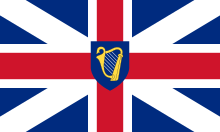
TheKingdom of Ireland,which had existed as a personal union with England since 1541, was unrepresented in the original versions of the Union Jack.[58]However, the flag ofthe Protectoratefrom 1658 to 1660 wasinescutcheonedwith thearms of Ireland.These were removed atthe Restoration,becauseCharles IIdisliked them.[59]
The original flag appears in the canton of the Commissioners' Ensign of theNorthern Lighthouse Board.This is the only contemporary official representation of the pre-1801 Union Jack in the United Kingdom[60]and can be seen flying from theirGeorge Streetheadquarters inEdinburgh.
This version of the Union Jack is also shown in thecantonof theGrand Union Flag(also known as the Congress Flag, the First Navy Ensign, the Cambridge Flag and the Continental Colours), the first widely usedflag of the United States,slowly phased out after 1777.

Lord Howe's action, or the Glorious First of June,painted in 1795, shows a Union flying fromHMSQueen Charlotteon the "Glorious First of June"1794. The actual flag, preserved in theNational Maritime Museum,is a cruder approximation of the proper specifications; this was common in 18th and early 19th century flags.[61][62]
The flag is also flown besideCustoms Housein Loftus Street,Sydney,to mark the raising of the Union Jack byCaptain PhillipatSydney Cove,the site of the first British settlement inNew South WalesandAustraliain 1788. On the plaque it is referred to as the "Jack of Queen Anne".
TheBritish Army's flag is the Union Jack, but in 1938, a "British Army Non-Ceremonial Flag" was devised, featuring a lion on crossed blades with theSt Edward's Crownon a red background. This is not the equivalent of the ensigns of the other armed services but is used at recruiting and military or sporting events, when the army needs to be identified but the reverence and ceremony due to theregimentalflags and the Union Jack would be inappropriate.
Scottish Union Flag
[edit]
In objecting to the design of the Union Flag adopted in 1606, whereby the cross of Saint George surmounted that of Saint Andrew, a group of Scots took up the matter withJohn Erskine, 19th Earl of Mar,and were encouraged by him to send a letter of complaint to James VI, via thePrivy Council of Scotland,which stated that the flag's design "will breid some heit and miscontentment betwix your Majesties subjectis, and it is to be feirit that some inconvenientis sail fall oute betwix thame, for our seyfaring men cannot be inducit to resave that flage as it is set down".[64]Although documents accompanying this complaint which contained drafts for alternative designs have been lost, evidence exists, at least on paper, of an unofficial Scottish variant, whereby the Scottish cross was uppermost. There is reason to think that cloth flags of this design were employed during the 17th century for unofficial use on Scottish vessels at sea.[65][66][67]This flag's design is also described in the 1704 edition ofThe Present State of the UniversebyJohn Beaumont,which contains as an appendixThe Ensigns, Colours or Flags of the Ships at Sea: Belonging to The several Princes and States in the World.[68]
On land, evidence confirming the use of this flag appears in the depiction ofEdinburgh CastlebyJohn Slezer,in his series ofengravingsentitledTheatrum Scotiae,c. 1693. Appearing in later editions ofTheatrum Scotiae,theNorth East View of Edinburgh Castleengraving depicts theScotch(to use the appropriate adjective of that period) version of the Union Flag flying from the Palace block of the Castle.[69]OnThe North Prospect of the City of Edenburghengraving, the flag is indistinct.[70]

On 17 April 1707, just two weeks prior to theActs of Unioncoming into effect, and with SirHenry St George, the younger,theGarter King of Arms,having presented several designs of flag toQueen Anneand herPrivy Councilfor consideration, the flag for the soon to be unifiedKingdom of Great Britainwas chosen. At the suggestion of the Scots representatives, the designs for consideration included that version of Union Jack showing the Cross of Saint Andrew uppermost; identified as being the "Scotts union flagg as said to be used by the Scotts".[71]However, the Queen and her Council approved Sir Henry's original effort, numbered "one".[71]
A manuscript compiled in 1785 by William Fox and in possession of theFlag Research Centerincludes a full plate showing "the scoth[sic]union"flag. This could imply that there was still some use of a Scottish variant before the addition of the cross of St Patrick to the Union Flag in 1801.[67]
After 1801
[edit]
The current and second Union Jack dates from 1 January 1801 with theAct of Union 1800,which merged theKingdom of Great Britainand theKingdom of Irelandto form theUnited Kingdom of Great Britain and Ireland.The new design added a redsaltire,thecross of Saint Patrick,for Ireland. This iscounterchangedwith the saltire of St Andrew, such that the red always follows the white clockwise. The arrangement has introduced a requirement to display the flag "the right way up" (seespecifications for flag useabove). As with the red cross, so too the red saltire is separated by a white fimbriation from the blue field.[33]This fimbriation is repeated for symmetry on the white portion of the saltire, which thereby appears wider than the red portion. The fimbriation of the cross of St George separates its red from the red of the saltire.
Apart from the Union Jack, Saint Patrick's cross has seldom been used to represent Ireland, and with little popular recognition or enthusiasm; it is usually considered to derive from the arms of the powerfulFitzGeraldfamily rather than any association with the saint.[72]
Flag speculation after Irish Free State establishment
[edit]When theAnglo-Irish Treatywas concluded on 6 December 1921 and the creation of the newIrish Free Statewas an imminent prospect, the question arose as to whether the cross of Saint Patrick should remain in the Union Jack.The New York Timesreported that on 22 January 1922:
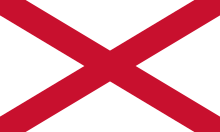
At theCollege of Armsit was stated that certain modifications were under consideration and that if any action were taken it would be done by the King in Council. No parliamentary action would be necessary. Heraldry experts say that alterations in arms are very expensive. Some years ago there was a demand from Irish quarters that the blue ground of the golden harp on the royal standard should be changed to green. It was then estimated that the alteration would cost at least £2,000,000. To remove all reference to Ireland from the present Union Jack and Royal Arms would be vastly more expensive.[73]
There was some speculation on the matter in British dominions also, with one New Zealand paper reporting that:
...the removal of the cross of St. Patrick Cross after 120 years will transform the appearance of the flag. It will certainly become a flag under which great victories were won in the seventeenth and eighteenth centuries, but to most minds the sentimental loss will be great. Probably it will be found that the deletion is not absolutely necessary. Other possible changes include the abolition of the title of the United Kingdom, and the removal of the harp from the Royal Standard and the Coat of Arms, and the substitution of the Ulster emblem.[74]
However, the fact that it was likely thatNorthern Irelandwould remain in the United Kingdom gave better grounds for keeping the cross of St. Patrick in the Union Jack. In this regard,Sir James Craig,thePrime Minister of Northern Irelandremarked in December 1921 that he and his government were "glad to think that our decision [to remain part of United Kingdom] will obviate the necessity of mutilating the Union Jack."[75]Though remaining within the United Kingdom, the new government of Northern Ireland dispensed with the St Patrick's Saltire in favour ofa new flagderived from thecoat-of-arms of the Burkes,Earls of Ulster, and quite similar to England's St George's Cross.

Ultimately, when the Britishhome secretarywas asked on 7 December 1922 (the day after the Irish Free State was established) whether theGarter King of Armswas "to issue any Regulations with reference to the national flag consequent to the passing of the Irish Free State Constitution Act", the response was no and the flag has never been changed.[76]
ADáil questionin 1961 mooted raising the removal of the cross of St Patrick with the British government; Frank Aiken, theIrish Minister for External Affairs,declined to "waste time on heraldic disputations".[77]
21st century
[edit]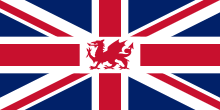
The lack of any Welsh symbol or colours in the flag is a result of Wales having been considered an integral part of the Kingdom of England at the time theflag of Great Britainwas created in 1606. Since there is no Welsh element in the Union Jack,Wrexham'sLabourMPIan Lucasproposed on 26 November 2007 in aHouse of Commonsdebate that the Union Flag be combined with theWelsh flagto reflect Wales's status within the UK, and that thered dragonbe added to the Union Flag's red, white, and blue pattern.[78]He said the Union Jack currently only represented the other three UK nations, andMinister for Culture, Creative Industries and TourismMargaret Hodgeconceded that Lucas had raised a valid point for debate. She said, "the Government is keen to make the Union Flag a positive symbol of Britishness reflecting the diversity of our country today and encouraging people to take pride in our flag." This development sparked design contests with entries from all over the world.[79]
In the run-up to the2014 Scottish independence referendum,various non-official suggestions were made for how the flag could be redesigned without the St Andrew's Cross if Scotland left the Union. However, as Scotland voted against independence, the issue did not arise.[80][81]
Status in the United Kingdom
[edit]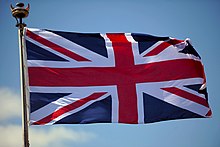
The Union Jack is used as ajackby commissioned warships and submarines of theRoyal Navy,and by commissionedarmyandRoyal Air Forcevessels. When at anchor or alongside, it is flown from thejackstaffat thebowof the ship. When a ship is underway, the Union Jack is only flown from the jackstaff when the ship is dressed for a special occasion, such as the King's official birthday.
The Union Flag is worn at the masthead of a ship to indicate the presence of the sovereign or anAdmiral of the Fleet.[82][unreliable source?]The Union Flag may also be flown from the yardarm to indicate that acourt-martialis in progress, though these are now normally held at shore establishments.
No law has been passed making the Union Jack the national flag of the United Kingdom: it has become one through precedent. Its first recorded recognition as a national flag came in 1908, when it was stated in Parliament that "the Union Jack should be regarded as the National flag".[83]A more categorical statement was made byHome SecretarySir John Gilmour,in 1933 when he stated that "the Union Flag is the national flag and may properly be flown by any British subject on land."[84]

Civilian use is permitted on land, but use of the unmodified flag at sea is restricted to military vessels. Unauthorised use of the flag in the 17th century to avoid paying harbour duties – a privilege restricted to naval ships – caused James's successor,Charles I,to order that use of the flag on naval vessels be restricted to His Majesty's ships "upon pain of Our high displeasure."[27]It remains a criminal offence under the Merchant Shipping Act 1995[85]to display the Union Flag (other than the "pilot jack" – see below) from a British ship. Naval ships will fly thewhite ensign,merchant and private boats can fly thered ensign,others with special permission such as naval yacht clubs can fly theblue ensign.All of the coloured ensigns contain the union flag as part of the design.
TheCourt of the Lord Lyon,which has legal jurisdiction in heraldic matters in Scotland, confirms that the Union Jack "is the correct flag for all citizens and corporate bodies of the United Kingdom to fly to demonstrate their loyalty and their nationality."[86]
On 5 February 2008,ConservativeMember of Parliament(MP)Andrew Rosindellintroduced the 'Union Flag Bill' as aprivate member's billunder the10 Minute Rulein theHouse of Commons.The Bill sought to formalise the position of the Union Flag as thenational flag of the UKin law, to remove legal obstacles to its regular display. The Bill did not receive itssecond readingby the end of thatparliamentary session.[87]The Bill stated "Union flag (commonly known as the Union Jack)" in subsection 1(1), but otherwise uses the term "Union Flag".[88]
Flag days
[edit]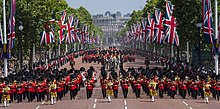
In July 2007, then-Prime MinisterGordon Brownunveiled plans to have the Union Flag flown more often from government buildings.[89]While consultation on new guidelines was under way, the decision to fly the flag could be made by each government department.[needs update]In March 2021, the UK government published new guidance for the Union Flag to be flown all year round on UK government buildings, unless another flag is being flown – such as another national flag of the UK, or a county flag, or other flags to mark civic pride.[90]
Previously, the flag was generally only flown on public buildings on days marking the birthdays of members of theroyal family,thewedding anniversaryof the monarch,Commonwealth Day,Accession Day,Coronation Day,themonarch's official birthday,Remembrance Sunday,and on the days of the State Opening andprorogationof Parliament. Non-government organisations were (and are) permitted to fly the Union Flag whenever they choose.
The latest specified set of days when the Union Flag should be flown from government buildings throughout the UK are:[91]
- Second Monday in March (Commonwealth Day)
- 9 April (anniversary of thewedding of The King and The Queen)
- 6 May (anniversary of thecoronation of The King and The Queen)
- Second Saturday in June (official birthday of The King)
- 21 June (birthday ofThe Prince of Wales)
- 17 July (birthday ofThe Queen)
- 8 September (anniversary of the accession ofThe King)
- Second Sunday in November (Remembrance Sunday)
- 14 November (actual birthday of The King)
In addition, the flag should be flown in the following areas on the specified days:
- Wales,1 March:Saint David's Day
- Northern Ireland,17 March:Saint Patrick's Day
- England,23 April:Saint George's Day
- Scotland,30 November:Saint Andrew's Day
- Greater London:the opening and proroguing of Parliament
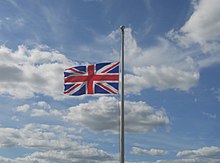
The Union Flag is flown athalf mastfrom the announcement of the death of the sovereign (save for Proclamation Day), or upon command of the sovereign.[92]
On 30 November,St Andrew's Day,the Union Flag can be flown in Scotland only where a building has more than one flagpole—on this day the Saltire will not be lowered to make way for the Union Flag if there is only one flagpole.[93]This difference arose afterMembers of the Scottish Parliamentcomplained that Scotland was the only country in the world that could not fly its national flag on its national day. However, on 23 April, St George's Day, it is the Union Flag of the United Kingdom that is flown over UK government offices in England.[94]
Usage and disposal
[edit]The Union Flag has no official status in the United Kingdom, and there are no national regulations concerning its use or prohibitions againstflag desecration.In Northern Ireland, theFlags Regulations (Northern Ireland) 2000provide for the flying of the flag on government buildings on certain occasions, when it is flown half-mast, and how it is displayed with other flags.[95]

The Flags and Heraldry Committee, anall-party parliamentary grouplobbying for official standards, cooperated with theFlag Institutein 2010 to publish a set of recommended guidelines for the flag's display and use as a symbol.[96]
There is no specific way in which the Union Flag should be folded. It is usually folded rectilinearly, with the hoist on the outside, to be easily reattached to the pole.[96][97]
Royal Navy Stores Duties Instructions, article 447, dated 26 February 1914, specified that flags condemned from further service use were to be torn up into small pieces and disposed of as rags (ADM 1/8369/56), not to be used for decoration or sold. The exception was flags that had flown in action: these could be framed and kept on board, or transferred to a "suitable place", such as a museum (ADM 1/8567/245).[33]
Position of Honour
[edit]
According to the UK Flag Protocol, the order of precedence of flags in the United Kingdom is: theRoyal Standards,the Union Flag, the flag of the host country (England, Scotland and Wales etc.), the flags of other nations (inEnglishalphabetical order), theCommonwealth Flag,the county flags, the flags of cities or towns, the banners of arms, and the house flags.[98]
British Overseas Territories and Crown Dependencies
[edit]
The Union Jack is the national flag of theBritish Overseas Territories,which are parts of the British realm with varying degrees of local autonomy. Most populated administrative regions and territories of the United Kingdom have been granted a unique flag for the locality, usually theBlue ensignorRed ensigndefaced with the distinguishing arms of the territory. All fly the Union Jack in some form, with the exception ofGibraltar(other than the government ensign).
TheCrown Dependencies,unlike the British Overseas Territories, are legally not part of the United Kingdom, and the Union Jack is not an official flag there. Outside the UK, the Union Jack is usually part of a specialensignin which it is placed in the upper left hand corner of a blue field, with a signifying crest in the bottom right. When the Union Jack and the territorial flag are flown together, the national flag is always arranged to take precedence over the territorial flag.[99]
Status outside the United Kingdom
[edit]Australia
[edit]
The Union Flag was used as a flag of Australia until 1953, although the Australianblue ensignsaw use as a governmental flag of Australia, and an informal national flag of the country since the early 20th century.[100]From 1911 to 1956, schools inSouth Australiawere required to fly the Union Jack for the "national salute".[101]
In 1953, the Australian blue ensign was named thenational flag of Australia,through theFlags Act 1953.[101]Although the Australian blue ensign replaced the Union Jack as the flag of Australia, Australian prime ministerRobert Menziestold Australians that the Union Flag would be flown together with the Australian national flag "on notable occasions".[101]Section 8 of thatFlag Actalso specified that the formalization of the Australian blue ensign as the national flag did "not affect the right or privilege of a person to fly the Union Jack."[102]The Union Jack continued to see informal use as a flag of Australia for a period thereafter, although by the 1980s, the majority of Australians viewed the Australian blue ensign as the national flag as opposed to the Union Jack.[103]
Canada
[edit]The Union Jack was the official nationalflag of Canadauntil 1965 when it was replaced in that role by the Maple Leaf flag.[104][105]Since 1965, the Union Jack in Canada is used as an authorised symbol to represent Canada's "membership in theCommonwealth of Nationsand its allegiance tothe Crown".[106]

History
[edit]The Union Jack has been used in a variety of colonies inBritish North Americasince its official adoption in 1707, In 1867, the British North American colonies ofNew Brunswick,Nova Scotia,and theProvince of Canadawere united to form theCanadian Confederation;with the Union Jack being retained as the official flag of the new "confederation".[104]
In addition to the Union Jack, during the late 19th century, a red ensign defaced with thearms of Canadawas also used as an informal flag of Canada. The defaced red ensign, later known as theCanadian Red Ensign,was eventually authorised for official use as the country's civil ensign in 1892. Although the Canadian Red Ensign was only formally authorised as a civil ensign, it was also viewed as ade factonational flag, as it was a uniquely Canadian symbol.[104]
In 1964, Canadian Prime MinisterLester B. Pearsonintroduced plans to replace the Union Flag with a new national flag, spurring theGreat Canadian flag debate.[104]A new national flag, theMaple Leaf,was approved by theparliament of Canadaon 17 December 1964.[104]However, on the following day, the Canadian parliament passed another resolution that designated the Union Flag as theRoyal Union Flagand authorised its official use as the symbol of the country's membership in the Commonwealth of Nations and its allegiance to the Crown.[106]The move was a concession given to those who preferred to adopt the Canadian Red Ensign as a formal national flag. On 15 February 1965, the maple leaf flag formally replaced the Union Flag as the flag of Canada following an official proclamation byElizabeth II,[104]with the Royal Union Flag becoming an official ceremonial flag.[106]

The Union Flag was also the formal flag for theDominion of Newfoundland,a separatedominionof the British Empire from 1907 to 1949.Newfoundlandretained the Union Flag as the province's official flag after it joined the Canadian confederation in 1949. In 1980, theflag of Newfoundlandwas adopted as the new provincial flag, with the design for the new flag of Newfoundland being derived from the Union Flag.
Protocol
[edit]The parliamentary resolution passed on 18 December 1964 assigned two purposes for the Royal Union Flag: a flag representing the United Kingdom and an official ceremonial flag of Canada.[105]When used to represent the United Kingdom, the flag takes precedence before the flag of a Canadian province or territory. However, when the flag is used as a ceremonial flag of Canada, the flag of a Canadian province or territory takes precedence before the Royal Union Flag.[105]

The parliamentary resolution requires the Royal Union Flag to be flown alongside the national flag of Canada (if there are at least two flag poles available) on federal properties onCommonwealth Day,Victoria Day(themonarch's official birthdayin Canada), 11 December (the anniversary of the enactment of theStatute of Westminster, 1931), and when otherwise instructed to do so by theNational Defence Headquarters.[106][105]The Royal Union Flag may also be formally flown alongside the flag of Canada at federal locations in Canada for ceremonies, anniversaries, and other events relating to theCanadian Armed Forcesor other forces in the Commonwealth.[106][105]
Items and properties that the parliamentary resolution applies to includes buildings operated by the federal government, military installations, federally-operated airports, at the masthead ofRoyal Canadian Navyships within Canadian waters, and other appropriate establishments. The requirement for federal properties to fly the Royal Union Flag applies only when there are two or more flagpoles on the property, to ensure that the national flag of Canada is not taken down in place of the Royal Union Flag.[106][105][107]
New Zealand
[edit]
The Union Flag became the flag of New Zealand after theTreaty of Waitangiwas signed in February 1840, replacing the flag used by theUnited Tribes of New Zealand.[108]The issue of flying the flag of the United Tribes alongside the Union Jack, as a symbol of their equal standing with the colonial government, served as a factor that led to theFlagstaff War,led byNgāpuhichiefHōne Heke.[108]British maritime flags were used by New Zealand vessels until 1865.[108]After the passage of theColonial Naval Defence Act 1865,vessels of the New Zealand government used a defacedblue ensignissued by the colonial government.
Thecurrent national flag of New Zealandwas given official standing under the New Zealand Ensign Act in 1902, replacing the Union Flag.[108][109]However, the Union Flag continued to see tandem use with the national flag of New Zealand into the 1950s.[108]
South Africa
[edit]The Union Jack was used as the flag of a variety of colonies in South Africa since 1795. The Union Jack was retained as the official flag of theUnion of South Africaafter its formation in 1910. In addition to the Union Jack, from 1910 to 1928, theSouth African Red Ensignwas also treated as an unofficial flag of the union.
Proposals to adopt a national flag were made during the 1920s. In 1927, the Union Nationality and Flag Act was passed by theParliament of South Africa,which named both the Union Jack and theOranje, Blanje, Blouflag of South Africa as the flags of the union, both co-equal in status. TheOranje, Blanje, Blouflag also incorporated the Union Jack in its design, alongside theflag of the Orange Free Stateand theflag of the South African Republic.The Union Jack was to be flown alongside theOranje, Blanje, Blouat principal government buildings in the capitals, at Union ports, on government offices abroad, and at such other places as the government might determine.[110][111]The act went into effect on 31 May 1928.
Instructions issued in 1931 confirmed the places where both flags were to be flown. In addition to those already mentioned, they were theUnion Buildingsin Pretoria, the head offices of the four provincial administrations, thesupreme courts,certainmagistrates' courts,customs houses, and three buildings inDurban(the general post office, therailway station,and the localmilitary district headquarters).[112][111]Under these arrangements, the Union Jack was subordinate to theOranje, Blanje, Blou.As the two flags had to be the same size, it meant that the Union Jack was made in the ratio 2:3 rather than the usual 1:2.[112][111]
This dual arrangement continued until 1957, when the Flags Amendment Act was passed naming theOranje, Blanje, Blouas the sole flag of South Africa.[113]TheOranje, Blanje, Blouwas replaced by theflag of South Africain 1994 as the country's national flag.
Use outside the Commonwealth
[edit]Several individuals residing in countries not a part of theCommonwealth of Nationshave adopted the Union Flag as a flag of protest.
Hong Kong
[edit]The Union Flag was formerly used in Hong Kong when it was aBritish Dependent Territory.Official use of the Union Flag and theBritish colonial Hong Kong flagceased following thehandover of Hong Kongto China in July 1997. In the 2010s, the Union Flag, along with the colonial flag of Hong Kong began to see use by supporters of thepro-democracy campduring the2014 Hong Kong protests,and the2019–20 Hong Kong protests.[114][115]The flag has been displayed at other pro-democracy events in Hong Kong, including thenew year marchesand the1 July marches.Members of theHong Kong Autonomy Movement,theHong Kong independencemovement andHong Kong localistshave been seen wielding the Union Flag or the colonial flag of Hong Kong.[116]
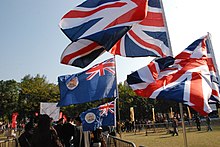
However, the meaning behind the use of the flags by pro-democracy protestors, including the Union Flag, remains disputed with protestors citing a variety of reasons for flying it.[117]Some pro-democracy protestors that flew foreign flags, including the Union Flag, did so in an effort to attract international media attention to the protests, while others did so in an effort to irritate the central government of China.[117][118]The Union Flag, in addition to other foreign flags, were also used by some protestors to illustrate their desire for Hong Kong to be an "international city"; whereas others used the flag simply as a generic symbol of freedom.[117][119][120]
Some specifically flew the Union Flag and the colonial flag of Hong Kong, nostalgic of the "values" of the previous colonial government, namely "personal freedoms, rule of law, [and] clean governance".[114][116]Other pro-democracy protestors choose to use the Union Flag and the colonial flag of Hong Kong in an effort to call upon the British government to declare that China had failed to uphold theSino-British Joint Declaration.[117]Several Hongkongers that holdBritish National (Overseas)passports who used the flag during the protests were doing so as a call to the British government to grant British National (Overseas) the right to abode in the United Kingdom.[117]Although a small number of Hongkongers seek direct British intervention into the matter, the majority of those that used the Union Flag or the colonial flag of Hong Kong during the protests do not hold such beliefs.[116]
The use of foreign flags at the protests, including the Union Flag, has been cited multiple times by the central government of China as evidence for their claim that foreign interference is steering the protests in Hong Kong against the central government.[117]Conversely, several protestors in the pro-democracy camp have also criticized the use of foreign flags, who view their use as reinforcing the claims made by the central government of China.[117]
Italy
[edit]After theBritish referendumon membership of theEuropean Unionresulted in a vote toleave,the Union Flag became a symbol ofeuroscepticismin Italy. In August 2016, many local businesses along theItalian rivierahoisted the flags as a protest against the implementation of theServices in the Internal Market Directive 2006.[121]
Use in other flags
[edit]National and regional flags
[edit]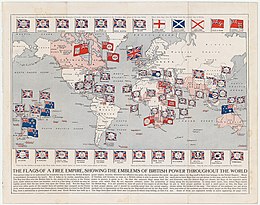
As the national flag of the entire British Realm, the Union Flag was found in thecanton(upper flagpole-side quarter) of theflagsof many colonies of Britain, while thefield(background) of their flags was the colour of thenaval ensignflown by the particularRoyal Navysquadron that patrolled that region of the world. Nations and colonies that have used the Union Flag at some stage have includedAden,Basutoland(now Lesotho),Barbados,Bechuanaland(now Botswana),Borneo,Burma,Canada,Ceylon(now Sri Lanka),Cyprus,Dominica,British East Africa (Kenya Colony),Gambia,Gold Coast (Ghana),Grenada,Guiana,Hong Kong,Jamaica,Labuan (Malaysia),Lagos,Malta,Mauritius,Nigeria,Palestine,Penang (Malaysia),Rhodesia(now Zimbabwe),Sierra Leone,Singapore,Somaliland,South Africa,Anglo-Egyptian Sudan,Pre-partitioned India(present-dayIndia,Pakistan,Bangladesh,andMyanmar),Tanganyika,Trinidad and Tobago,Uganda,theUnited States,andWeihaiwei.As former British Empire nations were granted independence, these and other versions of the Union Flag were decommissioned. The most recent decommissioning of the Union Flag came on 1 July 1997, when the former Dependent Territory of Hong Kong was handed over to the People's Republic of China.
Four former British colonies in Oceania which are now independent countries incorporate the Union Jack as part of their national flags: Australia, New Zealand andTuvalu,which have retained the monarchy; andFiji,whichabolished the monarchy in 1987.
In former British colonies, the Union Jack was used interchangeably with informal flags of the territory for significant parts of their colonial early history. The Union Flag was used as the flag of Canada until it was re-adopted as a ceremonial flag, and the Maple Leaf flag made the official national flag in 1965. In addition to being an official ceremonial flag, the Union Flag also defaces the flags of a number of Canadian provinces, includingBritish Columbia,Manitoba,andOntario.Newfoundland and Labradoruses a flag that was derived from the Union Flag, with the Union Jack serving as the flag of Newfoundland until 1980. The Union Flag, and flags defaced with the Union Flag in its canton, like the Canadian Red Ensign, continue to see use in Canada in a private capacity. The pre-1801 Union Flag also sees limited use by private organizations, most notably theUnited Empire LoyalistsAssociation of Canada.[122]
Along with the national flag, many otherAustralianflags retain the use of the Union Jack, including theRoyal Australian Navy Ensign(also known as the Australian White Ensign), theRoyal Australian Air Force Ensign,theAustralian Red Ensign(for use by merchant and private vessels), and theAustralian Civil Aviation Ensign.The flags of all six Australian States retain the Union Jack in the canton, as do some regional flags such as the Upper and LowerMurray River Flags.The Vice-Regal flags of the State Governors also use the Union Jack. While theFlags Act 1953states that Australians still have the "right or privilege" to fly the Union Jack after the introduction of the Australian National Flag, usage of the Union Jack by itself is unusual.
TheBasque Country'sflag, theIkurriña,is also loosely based on the Union Jack, reflecting the significant commercial ties betweenBilbaoand Britain at the time theIkurriñawas designed in 1894. TheMiskito peoplesometimes use a similar flag that also incorporates the Union Jack in its canton, due to long periods of contact in theMosquito Coast.
The Union Jack was used by the United States in its first flag, theGrand Union Flag.This flag was of a similar design to the one used by theBritish East India Company.Hawaii, a state of the United States but located in the central Pacific, incorporates the Union Jack in itsstate flag.Hawaii's flag represents the only current use of the Union Jack in any American state flag.
Also in the United States, the Union Flag of 1606 is incorporated into theflag of Baton Rouge,the capital city of Louisiana. Baton Rouge was a British colony from the time of theSeven Years' Waruntil the end of theAmerican Revolutionary War,when it was captured by Spanish forces. Symbols from the colonial powers France and Spain are also incorporated into the Baton Rouge flag.Taunton, Massachusetts,usesa flagwith the old style Union Flag by a resolution on 19 October 1974. Likewise,Westmoreland County, Pennsylvania,has been known to fly a flag containing the King's Colours since 1973.[123]
The Union Jack also appeared on both the 1910–1928 and 1928–1994flagsof South Africa. The1910–1928 flagwas aRed Ensignwith theUnion coat of armsin the fly. The 1928–1994 flag, based on thePrinsenvlagand commonly known as theoranje-blanje-blou(orange-white-blue), contained the Union Jack as part of a central motif at par with the flags of the twoBoer republicsof theOrange Free StateandTransvaal.To keep any one of the three flags from having precedence, the Union Jack is spread horizontally from the Orange Free State flag towards the hoist; closest to the hoist, it is in the superior position but since it is reversed it does not precede the other flags.
The flag of the Municipal Council ofShanghai International Settlementin 1869 contained multiple flags to symbolize the countries have participated in the creation and management of this enclave in the Chinese city of Shanghai. The Union Jack was contained as part of top left hand shield and close to the flags of the United States andFrance,there was also contained theflag of Prussianearby, but it was removed around 1917.
The flag of theChileancity ofCoquimbofeatures the Union Jack, owing to its historical commercial links to Britain.
-
Theflag of Bermuda,a British Overseas Territory
-
Theflag of the British Indian Ocean Territory,a British Overseas Territory
-
The flag ofBritish Virgin Islands,a British Overseas Territory
-
Theflag of the Cayman Islands,a British Overseas Territory
-
Theflag of the Cook Islands,an Overseas territory of New Zealand.
-
The flag of theFalkland Islands,a British Overseas Territory
-
The flag ofBritish Burma(1939–1948)
-
The flag ofBritish Cyprus(1922–1960)
-
The flag ofBritish Heligoland(1807–1890)
-
Theflag of India(1885–1947)
-
Theflag of Ceylon(1875–1948)
-
The flag of theCook Islands Federation(1893–1901)
-
Theflag of Hong Kong(1959–1997)
-
Theflag of Malta(1943–1964)
-
Theflag of Rhodesia(1964–1968)
-
Theflag of Singapore(1952–1959)
-
Theflag of British Trinidad and Tobago(1958–1962)
-
Theflag of the United States of the Ionian Islands(1815–1864)
-
Theflag of Weihaiwei(1903–1930)
-
Theflag of British Columbia,a Canadian province
-
Theflag of Hawaii,a U.S. state
-
Theflag of Manitoba,a Canadian province
-
CombinedMurray River Flag(Combined)
-
Murray River Flag(Lower)
-
Murray River Flag(Upper)
-
Theflag of Newfoundland and Labrador,a Canadian province
-
Theflag of Ontario,a Canadian province
-
Theflag of Queensland,an Australian state
-
The flag ofTaunton, Massachusetts
-
TheFlag of Victoria,an Australian state
Ensigns
[edit]The Union Flag can be found in the canton of several of theensignsflown by vessels and aircraft of the United Kingdom and its overseas territories. These are used in cases where it is illegal to fly the Union Flag, such as at sea from a ship other than a British warship. Normal practice for British ships is to fly theWhite ensign(Royal Navy), theRed ensign(Merchant and private boats) or theBlue ensign(government departments and public corporations). Similar ensigns are used by other countries (such asNew ZealandandAustralia) with the Union Flag in the canton. Other Commonwealth countries (such asIndiaandJamaica) may follow similar ensign etiquette as the UK, replacing the Union Flag with their own national flag.
-
HM CoastguardEnsign
-
Ensign of theNorthern Lighthouse Board
-
Blue ensign flown by vessels of theGovernment of Bermuda'sDepartment of Marine and PortsandBermuda Police Service Marine Section
-
Isle of ManRed Ensign
-
Gibraltar State Ensign
-
Cayman IslandsRed Ensign
-
Canadian Civil Ensign(1957–1965)
-
Canadian Naval Jack(1957–1965)
-
Royal Canadian Air Force Ensign(1940–1965)
-
Canadian Air BoardEnsign (1922–1923)
-
Canadian ArmyBattle flag (1939–1944)
-
Royal Canadian Sea CadetsEnsign (1953–1976)
-
Navy League of CanadaEnsign (1929–1965)
-
Dominion of NewfoundlandCivil Ensign (1907–1931)
-
New Zealand Civil Ensign
-
FijianNaval Ensign
-
Fijian Civil Ensign
-
Fijian Civil Air Ensign
-
Australian Civil Aviation Ensign(1935–1948)
-
UnofficialVan Diemen's Land Ensign
-
Royal Australian Air Force Ensign(1948–1982)
-
Royal Indian NavyEnsign
-
Indian ArmyEnsign
-
East India CompanyEnsign
-
Ensign of theSea Cadet Corps
-
Ensign of theRoyal Bermuda Yacht Club
Others
[edit]
This sectionneeds additional citations forverification.(May 2011) |

The flag in a white border occasionally seen on merchant ships was sometimes referred to as thePilot Jack.It can be traced back to 1823 when it was created as a signal flag, but not intended as a civil jack. A book[clarification needed]issued to Britishconsulsin 1855 states that the white bordered Union Flag is to be hoisted for a pilot. Although there was some ambiguity regarding the legality of it being flown for any other purpose on civilian vessels, its use as an ensign or jack was established well in advance of the 1864 Act that designated theRed Ensignfor merchant shipping. In 1970, the white-bordered Union Flag ceased to be the signal for a pilot, but references to it as national colours were not removed from the current Merchant Shipping Act and it was legally interpreted as a flag that could be flown on a merchant ship, as a jack if desired. This status was confirmed to an extent by the Merchant Shipping (Registration, etc.) Act 1993 and the consolidating Merchant Shipping Act 1995 which, in Section 4, Subsection 1, prohibits the use of any distinctive national colours or those used or resembling flags or pendants on Her Majesty's Ships, "except theRed Ensign,the Union flag (commonly known as the Union Jack) with a white border ", and some other exceptions permitted elsewhere in the Acts. However, Section 2 regards the" British flag ", and states that" The flag which every British ship is entitled to fly is the Red Ensign (without any defacement or modification) and, subject to (a warrant from Her Majesty or from the Secretary of State, or an Order of Council from her Majesty regarding a defacedRed Ensign), no other colours. "[124]The Flag Institute listed the white bordered Union Flag as "Civil Jack".[23]
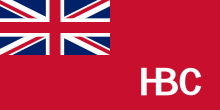
TheHudson's Bay Company(HBC) was one of a few non-government institutions using the Union Jack in part of the flag. HBC rivalNorth West Companyhad a similar flag as well. The HBC Red Ensign is no longer in use in 1965 and replaced with a corporate flag featuring the company's coat of arms.
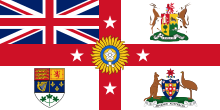
An unofficial flag for the British Empire was created around 1910 due to a belief that the Union Jack itself no longer sufficiently represented dominions such as Canada, which were beginning to adopt their own unique symbols. The flag was similar in design to a White Ensign, which features the Union Jack in the canton. In the other quadrants were the coats of arms of Canada, Australia, and South Africa. The four stars formingthe Cruxover Saint George's Cross represented New Zealand, and the Star of India was featured prominently in the middle. Civilians often flew Empire flags for patriotic events such as coronations,Empire Day,and theBritish Empire Exhibition.[125]It is still flown on special occasions at theDangarsleigh War Memorial.[126]
The Union Jack is the thirdquarterof the 1939coat of arms of Alabama,which is used on the flag of the governor of Alabama, representing British sovereignty over the state prior to 1783. The version used is the modern flag, whereas the 1707 flag would have been used in colonial Alabama.
In the former International Settlement ofKulangsuthe Kulangsu Municipal Police had a badge contained multiple flags, including the Union Flag. Then the badge is incorporated in their police flag.[127]
In popular culture
[edit]
The Union Jack remains one of the most instantly-recognisable flags in the world.[128][129]This is chiefly due not only to its iconic and unusual design, but the influence ofBritishcultureacross the globe as a result of theBritish Empire,and its resulting presence in severalCommonwealthnations' flags and heraldry. While most of the former colonies of the British Empire have chosen to omit the Union Jack in their national flags, some countries such asAustraliaandNew Zealandhave chosen to keep the Union Jack as a symbol of their British heritage.[130]
The Union Flag has been a prominent symbol in the sphere offashionsince theBritish Invasionmovement of the 1960s, in a similar manner to the AmericanStars and Stripes flag,and came back into fashion in the mid-1990s 'Cool Britannia' era, notablySpice GirlGeri Halliwell's iconicUnion Jack dressof the1997 Brit Awards.[131][132]A notable increase in popularity was seen inCubafollowing the2012 London Olympics,with clothing, nail decoration, tattoos, and hairstyles in youths being observed featuring the pattern.[133]
Subsumation in corporate branding
[edit]Commonly the Union Flag is used on computer software and Internet pages as aniconrepresenting a choice of theEnglish languagewhere a choice among multiple languages may be presented to the user, though the American flag is also sometimes used for this purpose. The flag has been embroidered on variousReebokequipment as a mark of the brand's British origin,[134]and the Reebok Union Jack has been referred to as a brand icon.[135]Many music artists have used the Union Jack, ranging from rock artiststhe Rolling Stones,the Who,the Jam,Sex Pistols,the Stone Roses,David Bowie,John Lennon,Paul McCartney,Freddie Mercury,Morrissey,Oasis,Iron Maiden,andDef Leppard,to the pop girl group theSpice Girls.
British Airwayspainted a cropped Union Flag on their tail fins until 1984, from 1997 on, they started painting a stylised, fluttering Union flag on tail fins, nicknamedChatham Dockyard Union Flag.The coat of arms of British Airways also features theescutcheoncropped from the Union Flag.[136]British Airways used the coat of arms on their aircraft via the Landor livery between 1984–1997 and added back in 2011, also used as cap badge for pilots or in advertisements.[137][138][139]
The BMW Mini tail lights are shaped after the Union Jack.[140]
Gallery
[edit]Union Flag variants 1606–1801
[edit] Coat of arms of Ireland 17th c. (Ireland) | St George's Cross 16th c. (England and Wales) | St Andrew's Cross 16th c. (Scotland) | |||||||||||||||||||||||||||
Flag of the Commonwealth 1649 (Commonwealth of England) | English Naval Jack Royal Navy 1643(England) | Scottish Union Flag (Unofficial) 1606 (Scotland) | |||||||||||||||||||||||||||
Union Flag of 1606 1606 (Union of the Crowns) 1660(Restoration) 1707(Great Britain) | St Patrick's Cross (Historical) 17th c. (Ireland) | ||||||||||||||||||||||||||||
Flag of the Commonwealthand Protectorate Jack 1658 (Commonwealth of England) | Union Flag of 1801 1801(United Kingdom) | ||||||||||||||||||||||||||||
Union Flag in folk art
[edit]-
The pennant flying onBritannia's boat in this 1793James Gillraycartoon is considerably different from the present flag.
-
A different style of the Union flag appears again in another cartoon byGillray
-
Side by side – Britannia!1918lithographbyJames Montgomery Flagg,showingUncle SamandBritanniawith a Union Jack shield
-
Fall back with theEureka Jackby Carlos Barrios, 2014.
See also
[edit]- Cross
- List of British flags
- Northern Ireland flags issue
- Star of India (flag)
- Union Jack Club
- Union mark of Norway and Sweden
Notes
[edit]- ^Graham Bartram (born 1963), a British vexillologist who is, as of 2013[update],the secretary-general for congresses of theFédération internationale des associations vexillologiquesand the chief vexillologist of the Flag Institute, when interviewed on theBBCBroadcasting Houseprogramme on 13 October 2013, stated that either name was perfectly valid whatever the purpose. He stated that the theory that the flag should only be referred to as "Union Jack" when flown at sea was wrong.[8]
References
[edit]- ^College of Arms (2023)."Union Flag: approved designs".Retrieved23 September2023.
For the avoidance of doubt and the sake of convenience, Garter King of Arms, under the authority of the Earl Marshal, has approved two versions of the Union flag as being accurate representations suitable for use. These are of the proportions 5:3, commonly flown on land; and 2:1, commonly flown at sea.
- ^"The Union Jack or The Union Flag?".The Flag Institute. 20 June 2014.Retrieved3 December2015.
- ^"Union Jack".The British Monarchy.Archived fromthe originalon 30 June 2013.Retrieved12 August2013.
- ^Canadian Heritage (10 March 2008)."Statement by the Hon. Jason Kenney, PC, MP, Secretary of State (Multiculturalism and Canadian Identity) on Commonwealth Day".Queen's Printer for Canada. Archived fromthe originalon 11 November 2011.
- ^Nicolls, Bruce."The Union Jack or The Union Flag?".The Flag Institute.Retrieved19 December2014.
- ^"Broadcasting House 13th October 2013".BBC.13 October 2013.Retrieved14 October2013.
- ^abcMarshall, Tim (2017).A flag worth dying for: the power and politics of national symbols.New York, NY: Scribner, an imprint of Simon & Schuster, Inc.ISBN978-1-5011-6833-8.OCLC962006347.
- ^Archived atGhostarchiveand theWayback Machine:"UNION JACK – discussion on BBC Broadcasting House".YouTube. 19 October 2013.Retrieved3 December2015.
- ^abcBartram, Graham."British flags".The Flag Institute.Retrieved2 May2007.
- ^Namely by King Henry VII, the first Tudor monarch of England (see imagescommons:Category:Coats of arms of King Henry VII of England)
- ^abcNicolls, Bruce."The Union Jack or The Union Flag?".The Flag Institute.Retrieved20 May2015.
- ^"UK Parliament".UK Parliament.Retrieved6 March2015.
- ^ab"Union of the Crowns".UK Parliament.Retrieved10 February2023.
- ^abJournal of the Royal United Service Institution, Whitehall Yard.W. Mitchell. 1895. pp. 181–185.Retrieved10 February2023.
- ^ab"-kin".Oxford English Dictionary(Online ed.).Oxford University Press.(Subscription orparticipating institution membershiprequired.)
- ^"John".Oxford English Dictionary.
- ^abc"Jack".Oxford English Dictionary.
- ^"Jack".Oxford English Dictionary.
- ^1633 quotation cited in"Jack".Oxford English Dictionary.
- ^"Union flag".Oxford English Dictionary(Online ed.).Oxford University Press.(Subscription orparticipating institution membershiprequired.)"Compare slightly later Union Jack"
- ^"jackstaff".Oxford English Dictionary(Online ed.).Oxford University Press.(Subscription orparticipating institution membershiprequired.)
- ^"About Us".The Flag Institute.Retrieved29 September2014.
- ^ab"British Flag Protocol".The Flag Institute.Retrieved12 March2015.
- ^"The Flying of the Union Jack".Parliamentary Debates (Hansard).Vol. 192. House of Lords. 14 July 1908. col. 579–580.Archivedfrom the original on 18 January 2012.Retrieved18 December2010.
- ^The Lords Commissioners of the Admiralty (1911) [1908],Manual of Seamanship,vol. I, London: HMSO, p. 20,
Note – A Jack is a Flag to be flown only at the "Jack" Staff,i.e.,a staff on the bowsprit or forepart of the ship.... In 1660 the Duke of York, later James II.) gave an order that the Union Flag should be worn only by the King's ships.
- ^Crawford, JR (1909)."Chapter XLI The Union Jack".InFox-Davies, Arthur Charles(ed.).A Complete Guide to Heraldry.New York: Dodge Publishing Company. pp. 611–617.
- ^abc Perrin, William Gordon (1922).British flags, their early history, and their development at sea: with an account of the origin of the flag as a national device.The University Press. p. 59.
- ^"No. 15324".The London Gazette.30 December 1800. p. 2.
- ^ Perrin, William Gordon (1922).British flags, their early history, and their development at sea: with an account of the origin of the flag as a national device.The University Press. p. 55.
- ^John Nichols,Progresses of James the First,vol. 4 (London, 1828), pp. 1043-4.
- ^ab"No. 15325".The London Gazette.3 January 1801. pp. 25–27.
- ^"No. 15325".The London Gazette.3 January 1801. pp. 23–24.
- ^abcdeUnited KingdomatFlags of the World
- ^"Churchill: The Power of Words".Archived fromthe originalon 16 August 2016.Retrieved16 August2016.
- ^Fowler, Jean, ed. (1990),Reed's Nautical Almanac 1990,New Malden, Surrey: Thomas Reed Publications Limited, pp. 16:2–16:3,ISBN0-947637-36-2
- ^"Naval Jack (U.S.)".Crwflags.com.Retrieved3 December2015.
- ^Salkie, Raphael (1990). "Outside the 'Free World'".The Chomsky Update: Linguistics and Politics.Unwin Hyman. p. 174.ISBN0-04-445589-5.
- ^Groom, Nick (2007). "Union Jacks and Union Jills". In Eriksen, Thomas Hylland; Jenkins, Richard (eds.).Flag, Nation and Symbolism in Europe and America.Routledge. p.81.ISBN978-0-415-44404-0.
- ^"SNP Face More Flak Over Flag Attacks".Daily Record.21 January 2006. Archived fromthe originalon 30 September 2007.
- ^Tracey, James D. (1997).The Political Economy of Merchant Empires: State Power and World Trade, 1350–1750.Cambridge University Press. p. 117.
- ^Ouyang, Yu (2013).Dịch tâm điêu trùng: – cá úc hoa tác gia đích phiên dịch bút ký.Niang Publishing. p. 236.ISBN978-986-5871-53-6.
- ^The European Magazine: And London Review.Vol. 39. Philological Society of London. 1801. p. 74.
- ^"Union Flag Bill 2007–08".UK Parliament.Retrieved9 April2014.
- ^"Union Flag Specification".The Flag Institute.Retrieved24 October2022.
- ^by the 1970s, "its current official dimension of l/30th the width of the flag"The Flag Bulletin,Volumes 12–14, Flag Research Center (1973), p. 85.
- ^"The World's Most Expensive Union Jack Sells For £384K".Archived fromthe originalon 11 August 2016.Retrieved10 August2016.
- ^abUnited Kingdom: 3:5 variantatFlags of the World
- ^ab"Union Flag: approved designs".www.college-of-arms.gov.uk.College of Arms. 2023.Retrieved23 February2023.
- ^ Grieve, Martin; Southworth, Christopher; Prothero, David."United Kingdom: Regimental Colours".Flags of the World.Retrieved9 July2009.
- ^Bartram, Graham (2004).British flags & emblems.East Linton: Tuckwell Press.ISBN978-1-86232-297-4.
- ^PANTONE."PANTONE 280 C – find a PANTONE Color".www.pantone.com.Archived fromthe originalon 29 December 2019.Retrieved16 November2017.
- ^PANTONE."PANTONE 186 C – find a PANTONE Color".www.pantone.com.Archived fromthe originalon 15 May 2021.Retrieved16 November2017.
- ^Perreira, Julian (18 February 2020)."Union Jack: Do You Know The Correct Way Up?".Forces Network.Retrieved28 May2020.
- ^"Flag mistake at UK-China ceremony".BBC News.3 February 2009.
- ^abDuffy, Jonathan (10 April 2006)."Union recognition".BBC.Archivedfrom the original on 30 November 2020.
·Graphic(archive of Graphic) - ^Fry, Plantagenet Somerset (1990).The Kings and Queens of England and Scotland.Grove Press. p. 127.ISBN978-0-8021-1386-3.
- ^Fox-Davies, Arthur Charles(1986) [1904].The Art of Heraldry: An Encyclopædia of Armory.London: Bloomsbury Books. p. 399.ISBN0-906223-34-2.
- ^ab"The History and Meaning of the Union Jack or Union Flag".Know Britain.Archived fromthe originalon 22 January 2016.Retrieved10 June2008.
- ^"Sunday 13 May 1660".The Diary of Samuel Pepys.Phil Gyford. 13 May 1660.Retrieved12 January2017.
- ^Northern Lighthouse Commissioner's FlagatFlags of the World
- ^"Command flag, Admiral of the Fleet, RN (before 1801)".The Collection.National Maritime Museum.AAA0730.Retrieved12 August2013.
- ^"Post Office Blue Ensign (before 1864)".The Collection.National Maritime Museum.AAA3687.Retrieved12 August2013.
- ^"The North East View of Edinburgh Castle".Slezer's Scotland.National Library of Scotland.Retrieved9 January2012.
- ^Hulme, Edward. F. (1897).The flags of the world: their history, blazonry and associations(txt).F. Warne & co. p. 152.
- ^Bartram, Graham (2005).British Flags & Emblems.Flag Institute/Tuckwell. p. 122.ISBN978-1-86232-297-4.
- ^Crampton, William (1992).Flags of the World.
- ^abSmith, Whitney (1973). "Title unknown".The Flag Bulletin.Flag Research Center.
- ^Beaumont, John(1704) [1701].The Present State of the Universe...Benj. Motte. p. 164.
- ^Slezer, John;Sibbald, Robert; Swall, Abel (1693).Theatrum Scotiae.John Leake. p. 114.
- ^"The North Prospect of the City of Edenburgh".Slezer's Scotland.National Library of Scotland.Retrieved9 January2012.
- ^abde Burton, Simon (9 November 1999)."How Scots lost battle of the standard".The Scotsman.Johnston Press plc.Retrieved30 June2009.[dead link]
- ^Hayes-McCoy, Gerard Anthony(1979).Ó Snodaigh, Pádraig(ed.).A history of Irish flags from earliest times.Dublin: Academy Press. p. 38.ISBN0-906187-01-X.
- ^"May Alter The Union Jack"(PDF).The New York Times.14 January 1922. Archived fromthe original(PDF)on 8 March 2021.
- ^"Signs of Heraldry".Ashburton Guardian.Vol. XLII, no. 9409.National Library of New Zealand.13 December 1921. p. 5.Retrieved9 January2012.
- ^"The Position of Ulster".Ashburton Guardian.Vol. XLII, no. 9413.National Library of New Zealand.16 December 1921. p. 5.Retrieved9 January2012.
- ^"National Flag (Irish Free State)".Parliamentary Debates (Hansard).Vol. 159. House of Commons. 7 December 1922. col. 2015W–2016W.Archivedfrom the original on 24 December 2012.Retrieved14 August2013.
- ^"Ceisteanna—Questions. Oral Answers. – Cross of St. Patrick on British Flag".Oireachtas.3 August 1961. p. 18.
- ^"Welsh dragon call for Union flag".BBC. 27 November 2007.
- ^Moore, Matthew (5 December 2007)."The new face of Britain Flag poll results".The Daily Telegraph.Archivedfrom the original on 11 January 2022.
- ^Judah, Sam (4 December 2013)."What would the union jack look like if the Scottish bit were removed?".BBC.Retrieved3 December2015.
- ^"The Union Jack: your designs".The Guardian.Retrieved3 December2015.
- ^"Use at Sea".Flags of the World.8 July 2011.Retrieved9 January2012.
- ^The Flying of the Union JackArchived18 January 2012 at theWayback Machine,Hansard,House of Lords Debate, 14 July 1908 vol 192 cc 579–580
- ^Official ReportArchived26 October 2016 at theWayback Machine(Hansard),27 June 1933; Vol. 279, c. 1324.Archived8 February 2016 at theWayback Machine
- ^The Merchant Shipping Act 1995 (1995 c. 21),London: The National Archives, 1995, section 2,retrieved1 March2015
- ^"The Union Flag".The Court of the Lord Lyon.Archived fromthe originalon 25 April 2018.Retrieved10 June2008.
- ^"Union Flag Bill 2007–08".UK Parliament.5 February 2008.
- ^"Union Flag Bill".UK Parliament.House of Commons. 13 October 2008.Retrieved19 February2022.
- ^"Brown lifts ban on national flag".BBC News.6 July 2007.Retrieved26 May2010.
- ^"Union flag to be flown on UK Government buildings every day".Government of the United Kingdom.Retrieved27 July2021.
- ^"Union Flag flying guidance for UK government buildings".Government of the United Kingdom. 5 February 2024.Retrieved21 April2024.
- ^"Flag Flying".Department of Culture, Media and Sport.Archived fromthe originalon 23 December 2008.Retrieved9 January2012.
- ^"Flag Flying 2011".Scottish Government.27 July 2011.Retrieved9 January2012.
- ^"Ministers agree flag day review".BBC News.20 May 2002.Retrieved9 January2012.
- ^The Flags Regulations (Northern Ireland) 2000(PDF)(347). 2000.
- ^abBartram, Graham; Flags & Heraldry Committee (2010).Flying Flags in the United Kingdom(PDF)(PDF). London:The Flag Institute.ISBN978-0-9513286-1-3.Archived fromthe original(PDF)on 11 June 2014.Retrieved13 August2014.
- ^Canadian Flag EtiquetteatFlags of the World
- ^"UK Flag Protocol – Position of Honour".Archivedfrom the original on 7 July 2020.Retrieved7 July2020.
- ^Bartram, Graham (2002)."A Guide to Flag Protocol in the United Kingdom (An extract from the book" British Flags and Emblems ")"(PDF).www.naco.uk.com.The National Association of Civic Officers (NACO).Retrieved5 September2021.
General Precedence: The Royal Standard; The Personal Flag of HM Queen Elizabeth The Queen Mother; The Personal Flag of HRH The Duke of Edinburgh; The Personal Flag of HRH The Prince of Wales; The Personal Flag of HRH Prince William of Wales; The Personal Flag of HRH The Duke of York; The Personal Flag of HRH The Earl of Wessex; The Personal Flag of HRH The Princess Royal; The Personal Flag of HRH The Duke of Gloucester; The Personal Flag of HRH The Duke of Kent; The Personal Flag of HRH Prince Michael of Kent; The Personal Flag of HRH Princess Alexandra; The Other Members' Standard; The Union Flag; The White Ensign of the Royal Navy; The Ensign of the Royal Air Force; The Blue and Red Ensigns; National Flag of the host constituent nation, crown dependency or over-seas territory; National Flags of England, Scotland, Wales, Crown dependencies and overseas territories; National Flags of other nations (in English alphabetical order); The United Nations Flag; The Commonwealth Flag; The European Union Flag; The British Army Flag; Counties and Metropolitan Cities; Other Cities and Towns; Banners of Arms (both personal and corporate); House Flags
- ^Kwan 2006,p. 10.
- ^abcKwan 2006,p. 8.
- ^Kwan 2006,p. 106.
- ^Kwan 2006,p. 6.
- ^abcdef"History of the National Flag of Canada".canada.ca.Department of Canadian Heritage. 4 February 2019. Archived fromthe originalon 12 September 2019.Retrieved27 November2019.
- ^abcdef"The Royal Union Flag".www.canada.ca.Government of Canada. 8 May 2018.Retrieved5 March2020.
- ^abcdef"Section 8: Other Flags".canada.ca.Department of National Defence. 4 February 2019. Archived fromthe originalon 22 January 2020.Retrieved27 November2019.
- ^Evan Dyer."We Stand on Guard for Whom? Union Jack at crossing sends mixed message – Ottawa – CBC News".Cbc.ca.Retrieved3 December2015.
- ^abcde"Flags of New Zealand Page 3 – Union Jack".nzhistory.govt.nz.New Zealand Government. 11 May 2015. Archived fromthe originalon 22 January 2020.Retrieved7 March2020.
- ^"The New Zealand Flag"(PDF).Scouting New Zealand.Archived fromthe original(PDF)on 28 July 2011.Retrieved9 January2012.
- ^Union Nationality and Flags Act 1927 (renamed 'Flags Act 1927' in 1949).
- ^abcRadburn, A. 'South Africa's Dual Flag Arrangement, 1928–1957' in SAVA NewsletterArchived26 April 2018 at theWayback MachineSN 74/16 (April 2016).
- ^abGovernment Gazette1953 (29 May 1931): Government Notice 376.
- ^Flags Amendment Act 1957
- ^abRoantree, Anne Marie (3 July 2019)."Flag-waving Grandma Wong gives Hong Kong protesters lesson in endurance".Reuters.Thomson Reuters.Retrieved26 June2020.
- ^Parry, Richard Lloyd; Blet, Raphael (14 June 2019),"Colonial nostalgia rules in Hong Kong as young refuse to accept China's authority",The Times,retrieved5 July2019
- ^abcChan, Holmes (13 July 2019)."Explainer: The conflicting messages behind protesters' use of the colonial Hong Kong flag".hongkongfp.com.Hong Kong Free Press.Retrieved26 June2020.
- ^abcdefgSum, Lok-kei (22 August 2019)."Are Hong Kong protesters pro-American or British when they wave the US and UK flags? The answer is complicated".South China Morning Post.SCMP Publishers.Retrieved26 June2020.
- ^Griffiths, James (26 June 2016)."Hong Kong handover: The protest symbols China's scared of".CNN.WarnerMedia.Retrieved25 June2020.
- ^Gourtsoyannis, Paris (13 June 2019),Union flags in Hong Kong are a symbol of failed China policy,The Scotsman,retrieved5 July2019
- ^Hannan, Daniel (15 June 2019),"Hong Kongers know the values behind the Union flag – but do the British?",The Telegraph,retrieved5 July2019
- ^Ghiglione, Davide (5 August 2015)."Italian beach operators hoist British flag in protest at EU law".Financial Times.Archived fromthe originalon 10 December 2022.Retrieved9 February2017.
- ^"History of the Loyalist Flag".www.uelac.org.United Empire Loyalists Association of Canada. Archived fromthe originalon 23 September 2019.Retrieved18 March2020.
- ^Westmoreland County, Pennsylvania (U.S.)atFlags of the World
- ^"Merchant Shipping Act 1995"(PDF).UK Public General Acts.The National Archives.19 July 1995.Retrieved17 January2010.
- ^Kelly, Ralph (8 August 2017)."A flag for the Empire"(PDF).The Flag Institute.Archived(PDF)from the original on 13 August 2023.Retrieved13 August2023.
- ^Ingall, Jennifer (4 June 2021)."Why the Dangarsleigh war memorial flies the Empire flag and what it means to the community".ABC News.Archivedfrom the original on 13 August 2023.Retrieved13 August2023.
- ^International Settlement of Kulangsu (Gulangyu, China)atFlags of the World
- ^"Top 10 Flags as Brands – Hammond Thinking".Retrieved21 February2021.
- ^"Flag of the United Kingdom".Encyclopedia Britannica.Retrieved21 February2021.
- ^Cable, Richard (10 January 2013)."The union jack: A very complex flag".BBC Knowledge & Learning.
- ^Amy de Klerk (22 February 2017)."It has been 20 years since Geri Halliwell wore the Union Jack dress".Harper's Bazaar.
- ^"Geri revisits Spice Girls' heyday in Union Jack dress".Hello Magazine.2 February 2012.Retrieved3 February2015.
- ^"Close Up: Cuba's new love for the Union flag".BBC News.Retrieved3 December2015.
- ^Brabazon, Tara (2000).Tracking the Jack: a retracing of the Antipodes.Sydney:University of New South Wales Press.p. 15.
- ^Upshaw, Lynn B. (1995).Building Brand Identity: A Strategy for Success in a Hostile Marketplace.John Wiley & Sons, Inc.ISBN0-471-04220X.
- ^"British Airways - Coat of arms (crest) of British Airways".Heraldry of the World.Archived fromthe originalon 24 February 2022.Retrieved24 February2022.
- ^"BA Uniforms".British Airways.Retrieved25 May2022.
- ^"Aviators, British Airways To Fly To Serve".British Airways.Retrieved24 February2022– via YouTube.
- ^"BA100: 41. The British Airways Coat Of Arms".London Air Travel. 16 August 2019.Retrieved26 May2022.
- ^"MINI".
Further reading
[edit]- Groom, Nick (2007).The Union Jack: The Story of the British Flag.Atlantic Books.ISBN978-1-84354-337-4.
- Kwan, Elizabeth (2006).Flag and Nation: Australians and their national flags since 1901.University of New South Wales Press.ISBN1-7422-4687-7.
- Lister, Davis (2014).Union Jack or Union Flag?(PDF).London:Flag Institute.
External links
[edit]| External images | |
|---|---|
- United KingdomatFlags of the World
- Union Jackat the Royal Family website
- Union Flag: approved designsat the College of Arms website
- Union Flag protocolat the College of Arms website
- British flags duringThe Protectorateand theCommonwealth of England– seeexternal link
- BBC page for 400th anniversary of flag
- Monochrome Union Flag not flown to avoid controversy
- How to draw the Union Jack
- Union Jack Flag Infographic
- History of the Union Jack video
- UK Flag Protocol
- Poll asks if Welsh element to Union flag idea is a flyer.BBC News.Published 26 September 2014.












































